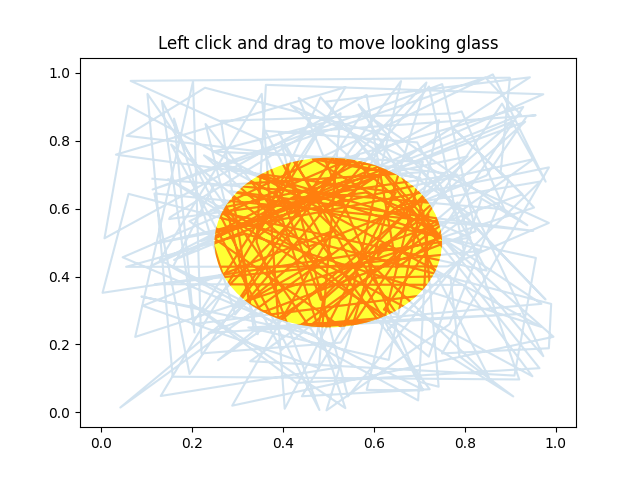Note
Click here to download the full example code
Looking Glass#
Example using mouse events to simulate a looking glass for inspecting data.
Note
This example exercises the interactive capabilities of Matplotlib, and this will not appear in the static documentation. Please run this code on your machine to see the interactivity.
You can copy and paste individual parts, or download the entire example using the link at the bottom of the page.
import numpy as np
import matplotlib.pyplot as plt
import matplotlib.patches as patches
# Fixing random state for reproducibility
np.random.seed(19680801)
x, y = np.random.rand(2, 200)
fig, ax = plt.subplots()
circ = patches.Circle((0.5, 0.5), 0.25, alpha=0.8, fc='yellow')
ax.add_patch(circ)
ax.plot(x, y, alpha=0.2)
line, = ax.plot(x, y, alpha=1.0, clip_path=circ)
ax.set_title("Left click and drag to move looking glass")
class EventHandler:
def __init__(self):
fig.canvas.mpl_connect('button_press_event', self.on_press)
fig.canvas.mpl_connect('button_release_event', self.on_release)
fig.canvas.mpl_connect('motion_notify_event', self.on_move)
self.x0, self.y0 = circ.center
self.pressevent = None
def on_press(self, event):
if event.inaxes != ax:
return
if not circ.contains(event)[0]:
return
self.pressevent = event
def on_release(self, event):
self.pressevent = None
self.x0, self.y0 = circ.center
def on_move(self, event):
if self.pressevent is None or event.inaxes != self.pressevent.inaxes:
return
dx = event.xdata - self.pressevent.xdata
dy = event.ydata - self.pressevent.ydata
circ.center = self.x0 + dx, self.y0 + dy
line.set_clip_path(circ)
fig.canvas.draw()
handler = EventHandler()
plt.show()
